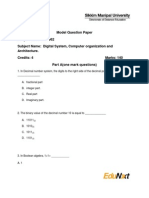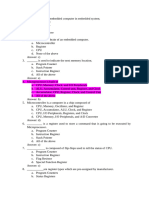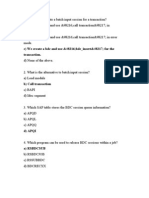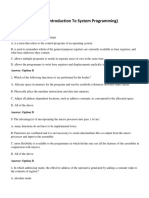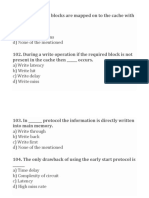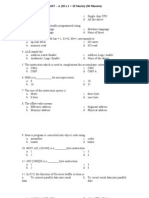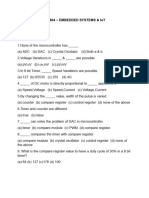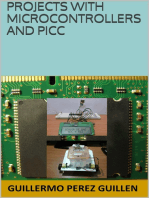MCQ1
MCQ1
Uploaded by
joshikaustubhp070Copyright:
Available Formats
MCQ1
MCQ1
Uploaded by
joshikaustubhp070Copyright
Available Formats
Share this document
Did you find this document useful?
Is this content inappropriate?
Copyright:
Available Formats
MCQ1
MCQ1
Uploaded by
joshikaustubhp070Copyright:
Available Formats
10. Timers may have one or more _____ for their reference timing.
a) time bases
b) analog outputs
c) unlatch inputs
11. Timers and counters use what is known as a (n) _____ and a (n) _____ to hold the target value
and the accumulated value.
a) holding count _ target holder
b) EN bit _ DN bit
c) pre-set register_ accumulated register
12. Counters can have outputs that turn ON when the accumulated count _____ the pre-set count.
a) both answers are correct
b) is equal to or less than
c) is greater than
13. Program/flow control instructions are used whenever you want to_______.
a) run some control modules
b) branch or divert execution of the program
c) stop the control program
14. Which of the following is not a typical flow control instruction:
a) REROUTE
b) GO SUB
c) MCR
15. An overflow condition signalled by an output coil means that ______________.
a) the operation is complete and correct
b) the result is available for another operation
c) the result is greater than the maximum value that can be held in the result register
16. In general double-precision arithmetic instructions use _____ as compared to single precision
Instructions.
a) more registers
b) less registers
c) the same number of registers
17. After a power failure a retentive timer’s ___________________.
a) Accumulated value stored is retained.
b) Pre-set value is kept but not the accumulated value.
c) Automatically resets when the power comes back on.
10.(a) 11.(c) 12.(a) 13.(b) 14.(a) 15.(c) 16.(a) 17.(a)
You might also like
- Chapter3:operating System, Quiz With AnswersDocument15 pagesChapter3:operating System, Quiz With AnswersAden Kheire Mohamed50% (2)
- Quiz 4 ReviewDocument32 pagesQuiz 4 Reviewsiva boyNo ratings yet
- Are Numbers and Encoded Characters Generally Used As OperandsDocument9 pagesAre Numbers and Encoded Characters Generally Used As OperandsAnurag ChitrakarNo ratings yet
- PLC MCQ Unit1Document6 pagesPLC MCQ Unit1pradnya sadigaleNo ratings yet
- The - Format Is Usually Used To Store Data.: A) BCD B) Decimal C) Hexadecimal D) OctalDocument27 pagesThe - Format Is Usually Used To Store Data.: A) BCD B) Decimal C) Hexadecimal D) OctalSuchit KumarNo ratings yet
- Question Bank - Mechatronics - Student's PDFDocument27 pagesQuestion Bank - Mechatronics - Student's PDFamarnathNo ratings yet
- MC0062 Digital Systems, Computer Organization & ArchitectureDocument26 pagesMC0062 Digital Systems, Computer Organization & ArchitecturemooumitaNo ratings yet
- Embedded QuestionsDocument7 pagesEmbedded QuestionsAdem AbdelaNo ratings yet
- Coa - Sample Mcqs - 24-25Document19 pagesCoa - Sample Mcqs - 24-25jaiaakash205No ratings yet
- Question Bank ROBOTICS UNIT - 3: A) Complicated To Design B) Unreliable C) Either 1 or 2 D) None of The AboveDocument3 pagesQuestion Bank ROBOTICS UNIT - 3: A) Complicated To Design B) Unreliable C) Either 1 or 2 D) None of The AboveNitish rajNo ratings yet
- Ch4 Test W AnswersDocument6 pagesCh4 Test W AnswersmemeNo ratings yet
- COA Tutorial 2 With AnsDocument5 pagesCOA Tutorial 2 With Anssarthaklakade2024No ratings yet
- Ec8552 - Cao MCQDocument27 pagesEc8552 - Cao MCQformyphdNo ratings yet
- EC5 Industrial Automation 2023Document10 pagesEC5 Industrial Automation 2023Rohit Kumar EC-04-2021No ratings yet
- MCQ of CODDocument8 pagesMCQ of CODmanikanta.reddy329No ratings yet
- Computer OrganizationDocument15 pagesComputer Organizationhollowpurple156No ratings yet
- ACA Question Bank 2024Document6 pagesACA Question Bank 2024jicomar193No ratings yet
- Basics of Electronics and Microprocessor MCQ'sDocument16 pagesBasics of Electronics and Microprocessor MCQ'srohi8975% (4)
- CSO MCQsetDocument6 pagesCSO MCQsetblackcreator420No ratings yet
- Arm MCQDocument12 pagesArm MCQAshok Kumar67% (6)
- Digital Control System Analysis & DesignDocument5 pagesDigital Control System Analysis & DesignTrinh Le TanNo ratings yet
- The Type of Memory Assignment Used in Intel Processors IsDocument26 pagesThe Type of Memory Assignment Used in Intel Processors IsSuchit KumarNo ratings yet
- Objective QuestionsDocument79 pagesObjective Questionspraveen24a9No ratings yet
- MSE 481 - Quiz I SolvedDocument2 pagesMSE 481 - Quiz I SolveddopyfuckNo ratings yet
- Starting Out With Python 4e (Gaddis) Chapter 4 Repetition StructuresDocument7 pagesStarting Out With Python 4e (Gaddis) Chapter 4 Repetition StructuresMengyi LyuNo ratings yet
- SP MCQDocument15 pagesSP MCQVishal KesharwaniNo ratings yet
- The Memory Blocks Are Mapped On To The Cache With The Help ofDocument26 pagesThe Memory Blocks Are Mapped On To The Cache With The Help ofSuchit KumarNo ratings yet
- Python5e Gaddis ch04Document6 pagesPython5e Gaddis ch04cyaxye391No ratings yet
- CaoDocument13 pagesCaoragavendharNo ratings yet
- TOPIC 2 Part 2 Machine Instructions and ProgramsDocument15 pagesTOPIC 2 Part 2 Machine Instructions and ProgramsQuang MinhNo ratings yet
- Tut QuestionsDocument28 pagesTut QuestionsSbahleNo ratings yet
- MPMCDocument11 pagesMPMCDEEPNo ratings yet
- Level 15 (Chapter 15 - Reduced Instruction Set Computers)Document12 pagesLevel 15 (Chapter 15 - Reduced Instruction Set Computers)tamldqe170103No ratings yet
- VivaDocument18 pagesVivaSumaya ShinosNo ratings yet
- ES MCQ CDACDocument53 pagesES MCQ CDACAshish Ghodke100% (2)
- Es MCQDocument31 pagesEs MCQAshish GhodkeNo ratings yet
- Or Mid 2 Objective QuestionsDocument8 pagesOr Mid 2 Objective QuestionsNARESH JAGATHKARINo ratings yet
- MCQ - Embedded SystemsDocument9 pagesMCQ - Embedded SystemsHemamalini VenugopalNo ratings yet
- Computer Architecture Unit 1 MCQDocument6 pagesComputer Architecture Unit 1 MCQRaagavi VNo ratings yet
- COA Tutorial 2Document5 pagesCOA Tutorial 2sarthaklakade2024No ratings yet
- TOPIC 2 Part 1 Machine Instructions and ProgramsDocument16 pagesTOPIC 2 Part 1 Machine Instructions and ProgramsQuang MinhNo ratings yet
- Ex. 1 - C01 - Assignment 4Document9 pagesEx. 1 - C01 - Assignment 4duongtnade170393No ratings yet
- Corrected Assignment With Answers (1)Document19 pagesCorrected Assignment With Answers (1)yh2985711No ratings yet
- PART - A (20 X 1 10 Marks) (30 Minutes)Document9 pagesPART - A (20 X 1 10 Marks) (30 Minutes)Deep AnNo ratings yet
- Maharana Prtap Group of Institutions Kanpur UNIT-3 (CS/EE)Document3 pagesMaharana Prtap Group of Institutions Kanpur UNIT-3 (CS/EE)QQQQQQQQQQQAQNo ratings yet
- Micro MCQSDocument16 pagesMicro MCQSSyed HamedoonNo ratings yet
- Computer Architecture McqsDocument10 pagesComputer Architecture McqsSatsshhNo ratings yet
- What Is Computer ArchitectureDocument8 pagesWhat Is Computer Architectureamutha dNo ratings yet
- A) B) C) D) : Part A: Review Questions (40 Points) I. Mcqs (10 Points)Document21 pagesA) B) C) D) : Part A: Review Questions (40 Points) I. Mcqs (10 Points)khalil alhatab86% (7)
- MCQ OsDocument5 pagesMCQ Oskushagra sharmaNo ratings yet
- Reviewer InstruDocument49 pagesReviewer InstruengrrlesNo ratings yet
- Upto 13th FebDocument9 pagesUpto 13th Feb21l106No ratings yet
- OS ToughDocument7 pagesOS ToughReoNo ratings yet
- Cs8491 Computer Architecture Unit - 3Document9 pagesCs8491 Computer Architecture Unit - 3ASIF MNo ratings yet
- Review Questions: Multiple ChoiceDocument8 pagesReview Questions: Multiple ChoiceExan JohnNo ratings yet
- Week 07Document14 pagesWeek 07lana_salahadinNo ratings yet
- DICA - Bits - Without Ans - docxQFWGDocument9 pagesDICA - Bits - Without Ans - docxQFWGkirankumarperamNo ratings yet
- Computer Organization MCQDocument7 pagesComputer Organization MCQbbsmdrNo ratings yet
- 1 Advanced Mould Manufacturing TechniquesDocument14 pages1 Advanced Mould Manufacturing Techniquescipet imphal100% (1)
- Projects With Microcontrollers And PICCFrom EverandProjects With Microcontrollers And PICCRating: 5 out of 5 stars5/5 (1)
- Drawing CH - 10,11,12-pDF - 0Document92 pagesDrawing CH - 10,11,12-pDF - 0joshikaustubhp070No ratings yet
- Byond Syllabus Eg PolygonDocument7 pagesByond Syllabus Eg Polygonjoshikaustubhp070No ratings yet
- 1 Sample Project Stage I Front PagesDocument8 pages1 Sample Project Stage I Front Pagesjoshikaustubhp070No ratings yet
- MCQ2Document2 pagesMCQ2joshikaustubhp070No ratings yet
- MCQ3Document2 pagesMCQ3joshikaustubhp0700% (1)
- Basic PLC Scada MCQDocument2 pagesBasic PLC Scada MCQjoshikaustubhp070No ratings yet
- Ghazy 12 PDFDocument245 pagesGhazy 12 PDFjoshikaustubhp070No ratings yet
- A Real-Time Data Acquisition System For Monitoring Sensor DataDocument5 pagesA Real-Time Data Acquisition System For Monitoring Sensor Datajoshikaustubhp070No ratings yet
- Ma Advanced Manufacturing Summit 4-29-2014 ReynoldsDocument10 pagesMa Advanced Manufacturing Summit 4-29-2014 Reynoldsjoshikaustubhp070No ratings yet
- Modeling of Vibration Measurements For Gear Fault and Damage Detection On AircraftDocument9 pagesModeling of Vibration Measurements For Gear Fault and Damage Detection On Aircraftjoshikaustubhp070No ratings yet






